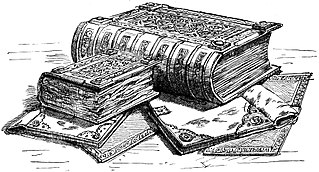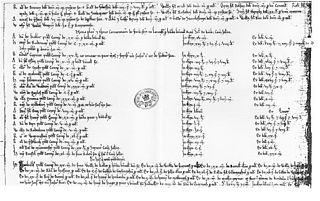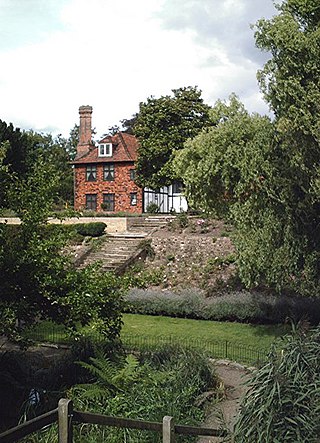
Year 1255 (MCCLV) was a common year starting on Friday of the Julian calendar.

Domesday Book is a manuscript record of the Great Survey of much of England and parts of Wales completed in 1086 at the behest of King William the Conqueror. The manuscript was originally known by the Latin name Liber de Wintonia, meaning "Book of Winchester", where it was originally kept in the royal treasury. The Anglo-Saxon Chronicle states that in 1085 the king sent his agents to survey every shire in England, to list his holdings and dues owed to him.

The Eleanor crosses were a series of twelve tall and lavishly decorated stone monuments topped with crosses erected in a line down part of the east of England. King Edward I had them built between 1291 and about 1295 in memory of his beloved wife Eleanor of Castile. The King and Queen had been married for 36 years and she stayed by the King’s side through his many travels. While on a royal progress, she died in the East Midlands in November 1290, perhaps due to fever. The crosses, erected in her memory, marked the nightly resting-places along the route taken when her body was transported to Westminster Abbey near London.
The Gloucester and Sharpness Canal is a ship canal in the west of England, between Gloucester and Sharpness; for much of its length it runs close to the tidal River Severn, but cuts off a significant loop in the river, at a once-dangerous bend near Arlingham. It was once the broadest and deepest canal in the world. The canal is 26.5 km long.
A hundred is an administrative division that is geographically part of a larger region. It was formerly used in England, Wales, some parts of the United States, Denmark, Southern Schleswig, Sweden, Finland, Norway, the Bishopric of Ösel–Wiek, Curonia, the Ukrainian state of the Cossack Hetmanate and in Cumberland County in the British Colony of New South Wales. It is still used in other places, including in Australia.

Alveston is a village, civil parish and former royal manor in South Gloucestershire, England, inhabited in 2014 by about 3,000 people. The village lies 1 mile (1.6 km) south of Thornbury and 10 miles (16 km) north of Bristol. Alveston is twinned with Courville sur Eure, France. The civil parish also includes the villages of Rudgeway and Earthcott.

Lancashire is a county of England, in the northwest of the country. The county did not exist in 1086, for the Domesday Book, and was apparently first created in 1182, making it one of the youngest of the traditional counties.

The constitutional status of Cornwall has been a matter of debate and dispute. Cornwall is an administrative county of England.
Gwenllian of Wales or Gwenllian ferch Llywelyn was the daughter of Llywelyn ap Gruffudd, the last native Prince of Wales. Gwenllian is sometimes confused with Gwenllian ferch Gruffudd, who lived two centuries earlier.

The Pipe rolls, sometimes called the Great rolls or the Great Rolls of the Pipe, are a collection of financial records maintained by the English Exchequer, or Treasury, and its successors, as well as the Exchequer of Ireland. The earliest date from the 12th century, and the series extends, mostly complete, from then until 1833. They form the oldest continuous series of records concerning English governance kept by the English, British, Irish and United Kingdom governments, covering a span of about 700 years. The early medieval ones are especially useful for historical study, as they are some of the earliest financial records available from the Middle Ages. A similar set of records was developed for Normandy, which was ruled by the English kings from 1066 to 1205, but the Norman Pipe rolls have not survived in a continuous series like the English.

The County Palatine of Durham was a jurisdiction in the North of England, within which the bishop of Durham had rights usually exclusive to the monarch. It developed from the Liberty of Durham, which emerged in the Anglo-Saxon period. The gradual acquisition of powers by the bishops led to Durham being recognised as a palatinate by the late thirteenth century, one of several such counties in England during the Middle Ages. The county palatine had its own government and institutions, which broadly mirrored those of the monarch and included several judicial courts. From the sixteenth century the palatine rights of the bishops were gradually reduced, and were finally abolished in 1836. The last palatine institution to survive was the court of chancery, which was abolished in 1972.
Bullingdon was a hundred in the county of Oxfordshire, covering an area to the east of Oxford. It took its name from the hamlet of Bullingdon Green, in the parish of Horspath, where the hundred court originally met.
Helen Maud Cam, was an English historian of the Middle Ages, and the first woman to be appointed a tenured professor at Harvard University.

Sir Richard de Southchurch was a knight and part of the landowning aristocracy of Essex in the thirteenth century. He was High Sheriff of Essex and of Hertfordshire in the years 1265–67, and as such became involved in the Second Barons' War (1264–1267). Southchurch has earned a special place in the historiography of the period due to an episode during the war where he allegedly planned to attack London with incendiary cocks.

Glympton is a village and civil parish on the River Glyme about 3 miles (5 km) north of Woodstock, Oxfordshire. The 2001 Census recorded the parish's population as 80. The village and church are owned by the Glympton Park estate.

The Royal Commission on Historical Manuscripts, was a United Kingdom Royal Commission established in 1869 to survey and report on privately owned and privately held archival records of general historical interest. Its brief was "to make inquiry as to the places in which such Manuscripts and Papers were deposited", and to report on their contents. It remained in existence until 2003, when it merged with the Public Record Office to form The National Archives. Although it technically survives as a legal entity, its work is now entirely subsumed into that of The National Archives.
The Kent Hundred Rolls are the documentary result of a 13th-century Crown inquiry or census into the rights of the English monarchy over land and property in the Hundreds of the county of Kent. The Rolls are preserved in the English National Archives as part of the national Hundred Rolls.
Events from the 1250s in England.
Subsidy rolls are records of taxation in England made between the 12th and 17th centuries. They are often valuable sources of historical information.
John Crakehall was an English clergyman and Treasurer of England from 1258 to 1260. Possibly the younger son of a minor noble family in Yorkshire, Crakehall served two successive bishops of Lincoln from around 1231 to the 1250s. He then became an archdeacon in the diocese of Lincoln before being named as treasurer, where he served until his death in 1260. He owed his appointment to the treasurership to a number of factors, including his reputation for administrative ability and his relationship with the leader of the baronial effort to reform royal government. While in office, he strove to improve the administration of the exchequer as well as collect outstanding debts to the government and improve royal revenues.